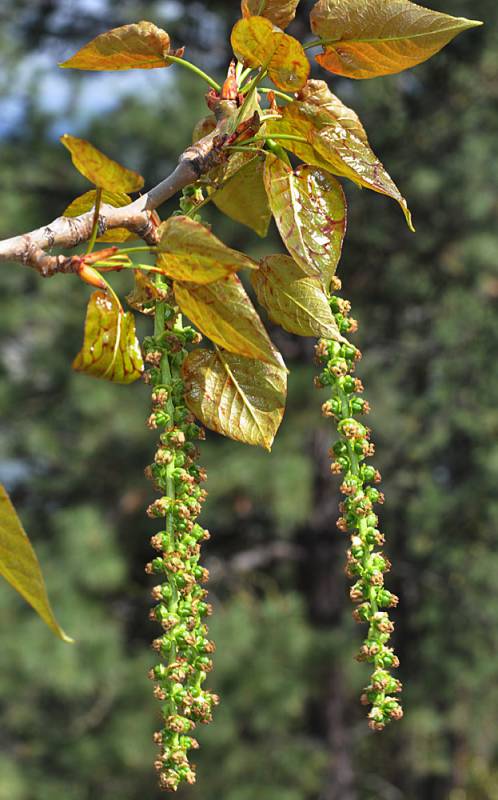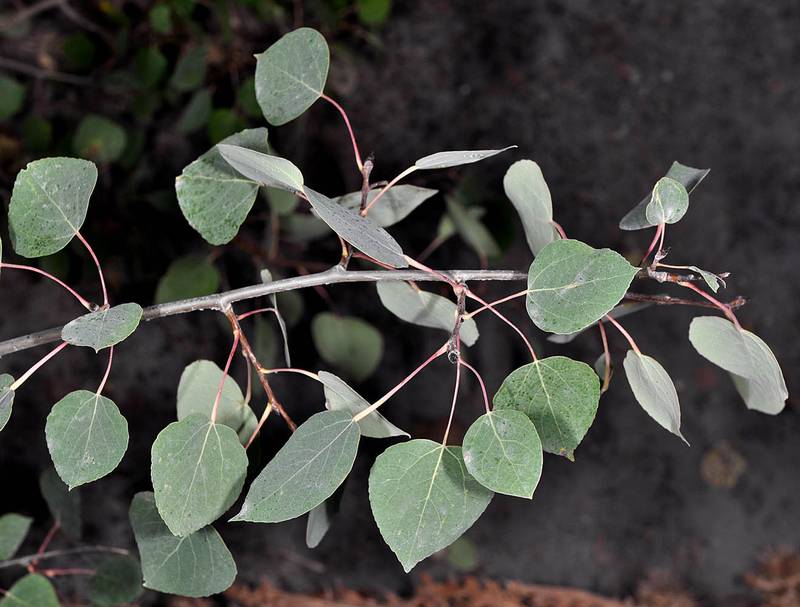Populus trichocarpa
Populus tremuloides
black cottonwood
quaking aspen
Leaves alternate, the blades fragrant, strongly resinous, the lower side distinctly paler than the upper, variable in shape, 5-15 cm. long and 3-9 cm. wide, broadest below the middle, pointed at the tip and usually rounded or truncate at the base, the surfaces usually glabrous;
petioles terete, about half as long as the blade.
Leaves alternate, relatively small, on slender, laterally-flattened petioles half to fully as long as the blade;
blades rotund-ovate to reniform-cordate, 2.5-9 cm. long and 2.5-8 cm. wide, shortly acuminate, paler beneath, the margins finely toothed and hairy, the surfaces glabrous at maturity.
Catkins drooping; the bracts subtending the flowers in the catkins lacerate-fringed; staminate catkins elongating to 2-3 cm, then deciduous; pistillate catkins at maturity 8-20 cm. long;
stigmas 2, broadly dilated.
Catkins drooping; the bracts subtending the flowers in the catkins persistent, deeply cleft into a few slender lobes with long, white hairs on the margins; staminate catkins elongating to 2-3 cm. then deciduous;
stamens 6-14; pistillate catkins at maturity 4-10 cm. long, with numerous fruits;
stigmas 2, each deeply cleft into 2 or more slender lobes.
Capsules rotund-ovate, 5-8 mm. long, sub-sessile.
Capsules lanceolate, 4-6 mm. long, on pedicles 1-2 mm. long
Populus trichocarpa
Populus tremuloides
- Local floras:
CA,
OR,
WA
- Local Web sites:
CalFlora,
CalPhotos,
Flora NW,
PNW Herbaria
WildflowerSearch
iNaturalist (observations)
USDA Plants Database
- LBJ Wildflower Center
- SEINet
- Plants of the World Online
- Encyclopedia of Life
- Wikipedia
- Google Image Search
- Local floras:
BC,
CA,
OR,
WA
- Local Web sites:
CalFlora,
CalPhotos,
Flora NW,
PNW Herbaria
WildflowerSearch
iNaturalist (observations)
USDA Plants Database
- LBJ Wildflower Center
- SEINet
- Plants of the World Online
- Encyclopedia of Life
- Wikipedia
- Google Image Search



